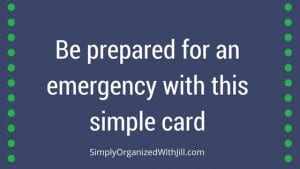Be prepared for an emergency with this simple card

Emergency medical professionals want to provide the best treatment possible to their patients and also let your loved ones know you are experiencing a crisis. This is very difficult to do when you are unresponsive. Make their job easier by taking the advice of my medical professional friend who suggests everyone carry an “in case of an emergency” medical card in their wallet. She has helped many patients in the emergency room who haven’t had this information with them.
It’s stressful for everyone if the staff isn’t able to contact the patient’s loved ones and their pertinent medical information isn’t available.
Write your current list of medications and allergies on the card. Include your birth date, insurance policy numbers, and your doctor’s name and phone number if that information isn’t already in your wallet. In addition, list two emergency contact names and their phone numbers. Frequently update all this information.
Even if you are responsive you may be too ill or confused to remember. Case in point: My dad required an ambulance ride to the emergency room and although he was responsive, he didn’t have his family phone numbers memorized. Fortunately, I quickly tracked him down.
Create your emergency card with a free, online template. Simply search “in case of an emergency card,” fill in your information, print and laminate the card at an office supply store. There are also i.d. bracelets you can purchase online if you search “emergency medical id.”
Contacts should be listed on your mobile phone under the acronym ICE — in case of emergency. If your phone is password protected or the battery isn’t charged, emergency personnel won’t be able to access it. That’s when the card will come into play.
I’m grateful my friend approached me with this suggestion because it’s something we can easily overlook until needed. Is there an in case of an emergency card in your wallet?
